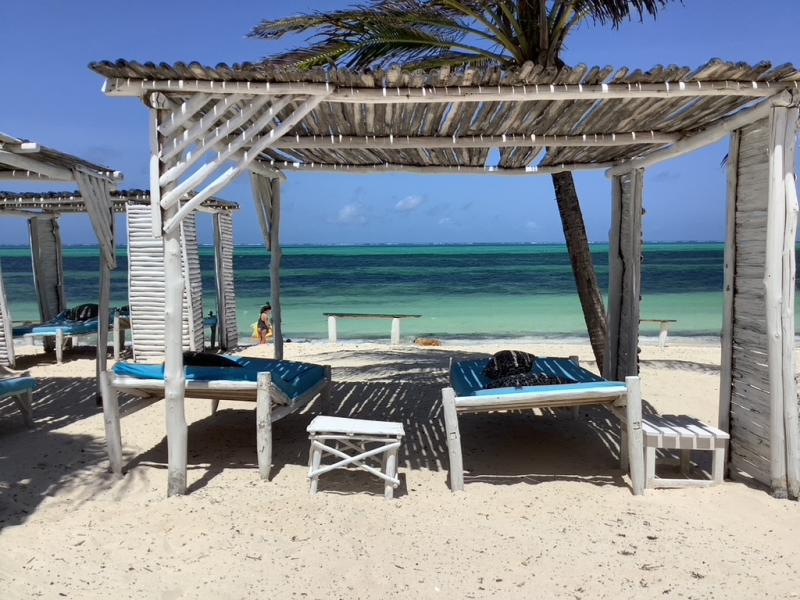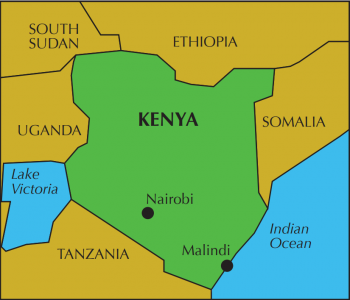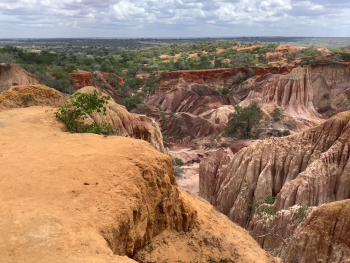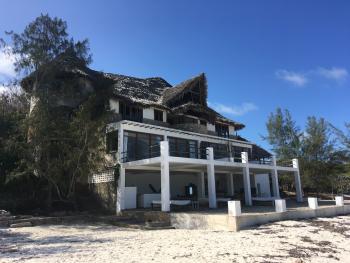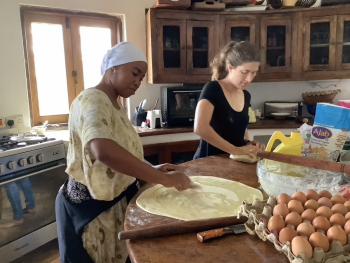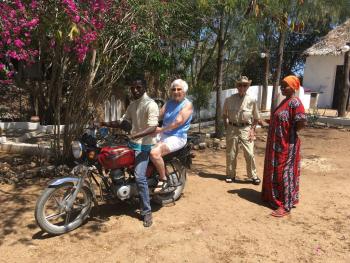Four generations gather together to enjoy family time on Kenya’s beautiful coast
This article appears on page 6 of the December 2021 issue.
Our granddaughter and her family serve as missionaries in Ethiopia, a very long way away. Their internet is unreliable and communication is spotty. Letters and packages mailed to them take weeks, months or never reach them at all. So we came up with a plan for the whole family to spend two weeks together.
The Beach House (Casurina Rd., Mayunga; email the owner, Rory Keegan, at rory_keegan@yahoo.com or visit www.airbnb.com/rooms/14374825), located near the little village of Malindi on the Indian Ocean coast of Kenya, had everything we wanted.
Making plans
Planning the July 28-Aug. 10, 2021, trip was more complicated than usual because of COVID. We had to get a PCR test within three days of departure, and we had to fill out a health questionnaire online to get the QR stamp we were required to show at the airport. We also had to apply for our Kenyan visas online and get return approvals.
We took out travel insurance (Travel Insured International) to cover any medical costs we might incur and emergency evacuation. At our ages (89 and 90), it was a bit pricey ($525 each) but well worth it for peace of mind.
We started our long trip at Chicago’s O’Hare International Airport with our son Larry and his wife, Carol. I had wheelchair assistance because of recent hip surgery, and my husband, Al, who is still quite chipper, walked along beside me.
The wheelchair driver took the passports and documents from all four of us and walked them to the head of the line. We were well cared for — one of the perks of getting old.
When I made our flight reservations with Ethiopian Airlines, I paid extra so we would have front-row bulkhead seats. This was important for me because I walk with a cane and need to be near the WC. The seat selections cost $100 each for the long overnight flights and $50 each for the shorter flights, a total of $1,600 for our family of four.
Unfortunately, our confirmed seats were changed on every flight. They said it was because the aircraft had been changed, but we noticed the front-row bulkhead seats were always 3, 3 and 3. On one flight, I was the only one of our family group sitting in a confirmed seat. (The lady sitting next to me, where my husband should have been, said she had not paid extra for the seat but just went where she was told to go.)
On one of the return legs of our trip, they had us scattered all over the plane; none of us were together. When my son stormed the gate and demanded that we be given the seats we had paid for, they acquiesced, without apology. (I’m in the process of requesting a refund of the $1,600 from Ethiopian Airlines.)*
Nevertheless, we had a very nice 14-hour direct flight from Chicago to Addis Ababa, Ethiopia ($1,794 each). At the ultramodern new airport there, we were met by our granddaughter Allison and her husband, Adam, along with their kids, Adeline (6 years old), Cecelia (4) and baby Samuel (10 months). The girls were jumping up and down with joy and excitement at seeing Gram and Gramps again.
We continued on a short flight to Mombasa, the second-largest city in Kenya, where a large SUV taxi met us for a 3-hour drive through the city, the countryside and then miles over an incredibly rough, bumpy road to The Beach House (taxi ride, $130).
The staff of three greeted us at the house, took our luggage to our rooms and had a very welcome warm dinner ready for us. Once we were ready for bed, the sound of waves put us to sleep.
Our accommodations
The Beach House was well suited to the needs of our three family groups ($270 a day for 13 days).
We had the use of the whole house, which was very large. The lower level was open and had tables and chairs and direct access to the beach. The main level had three bedrooms, each with facilities en suite, and a wall of windows on the beach side. Sliding doors opened to a terrace.
One of the bedrooms had a queen-sized bed and two single beds plus a variety of furniture — perfect for the young family.
Our bedroom, called the “indoor-outdoor room,” had a king-sized bed and a door that opened into an open-air room. (The windows were just big, open spaces, but the overhanging thatch kept the rain from coming in… though it didn’t stop the wind!) The built-in king-sized bed with lots of pillows in that room was a wonderful play area for Samuel and his sisters.
Up one more level was the kitchen, dining room and living room plus a lounge room that was open to the ocean.
Spiral stairs led to a fourth bedroom in the tower. It had windows all around and a great view of the ocean. However, it lacked a bathroom, and the wind rattled the window slats so much in the night that it was hard to sleep there.
The kitchen was very spacious, and it did have a microwave oven, but one spigot on the sink didn’t work, and the refrigerator door was held closed by a makeshift arrangement. The whole house needed some maintenance, but nothing serious, so we could live with it.
It was a very tall house, and the third-story windows were wide open, letting the breeze in all the time. An occasional bird flew in and hopped around on the floor looking for crumbs.
Our location was just 3 degrees south of the equator, and the weather was almost perfect. All year it remains close to 80°F, day and night, with quite a breeze at all times.
The house, located on 10 acres, was built right on the beach, with 250 meters of beach frontage. This was a big draw for the girls. Even before breakfast, they were out there with Gram picking up shells and bits of coral. They never tired of running on the sand, splashing in the water and building sand castles.
Meals
Rehema and her husband, Ali, were the caretakers and cooks. They lived in a small house next to the “big house.” A young man, Sam, helped with the kitchen and housecleaning.
Our son Larry and grandson-in-law Adam took over the meal planning. They either took a taxi into town and bought groceries or gave money to Rehema.
For the grand sum of $20 a day, the kitchen crew did all the cooking, serving and cleanup. What a bargain!
Sometimes we fixed our own breakfast of cereal and fruit, but often they would prepare scrambled eggs and big, fat sausages and fresh orange juice — and mangoes! The mangoes were so delicious that we had them almost three times a day.
Our meals were simple but very good. Lots of potatoes and rice and often fish. One night we had white snapper, caught that morning. The two fish had been perfectly baked and seasoned, then brought to the table intact with their heads and tails. The girls had a strong reaction, saying, “I’m not eating any dead fish!,” but it was delicious.
Rehema was a pro at making chapati, a flat bread, and one day she taught Allison how to make it. A yeast dough was rolled into two big circles with a rolling pin that was originally a chair leg. It worked great!
The dough was sprinkled with oil and then cut into long strips. She wrapped the strips around her hand to make a ball, and then the ball was rolled out again into a smaller circle before being put in a hot pan and cooked quickly on each side. At dinner, we spooned beans into the chapati and folded it over — very good.
An adventure on the water
One morning, our taxi arrived at 9:30 and we all piled in, enduring the jarring, bone-shaking road. We lurched and bounced, but the little girls sat quietly and the baby fell asleep. (They were used to it, telling us the roads in Ethiopia were much worse.)
We drove through small villages with crude buildings made of sticks and stones in addition to colorful stalls selling food and clothing before reaching the marina, where we had reservations for a glass-bottom boat ride (three hours for $80). The boat was waiting, and we were surprised that we had to wade out to it, across sandbars and then through shallow water, about 100 yards. My husband and I both had shoes to wear in water, so we just rolled up our pant legs.
A strong man on each side of me helped to make sure I didn’t fall, then they hoisted me into the boat.
We had expected a sleek boat with an all-glass bottom, but the boat was in disrepair, with a piece of dirty plexiglass about 2 by 6 feet in the bottom. The children were fascinated, however, to see occasional fish flash by; even Samuel squealed and jabbered at them.
Meanwhile, the others donned snorkeling gear and jumped into the water. The snorkeling was great, and they reported seeing beautiful, brilliantly colored fish and even an octopus! Al and I enjoyed the snorkeling experience vicariously.
When it was time to return to shore, it was low tide and the shore was about a quarter mile away, though the boat got as close as it could. The same two strong men shepherded me all the way back. With a few rest stops, I made it.
The taxi (a small bus), which stayed with us all day, cost $60.
Day trips were alternated with days at the house, with plenty of time to read stories, draw and paint pictures and play hide-and-seek.
A few more sights
One day we went to Kenya’s small version of our Grand Canyon, the Marafa Depression, known locally as “Hell’s Kitchen.” It was spectacular! Layers of red, yellow, gold and white sandstone were all bathed in bright sunshine — a photographer’s dream.
The rest of the family went on a guided walk through the canyon ($3 per person plus $3 for the guide) while I enjoyed the view from the top. There were no other tourists — usually this is a very popular place, with many visitors — and they were very glad to see us.
There was also a game reserve not far from the beach house claiming a variety of animals, including giraffes, impalas, wildebeests and even an elephant. However, their website said the chances of seeing them were from 0% to 3%.
We decided to go anyway, so we rented a taxi for four hours ($60). I don’t remember the admission fee, but it’s just as well, as it was the worst experience of our trip.
We transferred into the reserve’s vehicle, which by some miracle was still running, and we did see a small elephant shrew, but that was it.
The narrow road through the game reserve seemed to follow a creek bed and was full of rocks, logs and boulders. The vehicle struggled to get over them. We were so glad when we were out of there safely.
These day trips always ended with time to play on the beach. Adeline and Cecelia never ran out of energy. What is a more joyful scene than two little girls running on the beach with their hair flying?
On our last night, we had a bonfire on the beach. We watched the flames and the sparks flying in the air, arms wrapped around children as we recalled the good times we had experienced. Precious memories till we meet again!
*ITN wrote to Ethiopian Airlines about the Moores’ seat-selection issue and received no reply.

